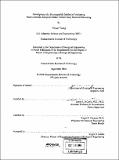| dc.contributor.advisor | James J. Di Carlo. | en_US |
| dc.contributor.author | Vuong, Yihvan, 1981- | en_US |
| dc.contributor.other | Massachusetts Institute of Technology. Biological Engineering Division. | en_US |
| dc.date.accessioned | 2005-09-27T18:45:47Z | |
| dc.date.available | 2005-09-27T18:45:47Z | |
| dc.date.copyright | 2004 | en_US |
| dc.date.issued | 2004 | en_US |
| dc.identifier.uri | http://hdl.handle.net/1721.1/28864 | |
| dc.description | Thesis (M. Eng.)--Massachusetts Institute of Technology, Biological Engineering Division, 2004. | en_US |
| dc.description | Includes bibliographical references (leaf 43). | en_US |
| dc.description.abstract | (cont.) electrodes. | en_US |
| dc.description.abstract | Flexible multi-electrode arrays represent an evolving technology for chronic deep neuronal recording. We focus on developing a biocompatible method of implanting a novel 12-electrode device for long-term recording (weeks to months) in a deep target responsible for object identification, the inferotemporal cortex (IT). Numerous electrodes embedded in a bioerodible polymer matrix composed of 50/50 poly(D,L-lactide-co-glycolide) created an electrode bundle that was sufficiently stiff for insertion into brain tissue, but was expected to become more flexible after polymer degradation. Titanium electrode ports used to house these multi-electrode arrays were successfully designed, constructed, and implanted on a non-human primate as well. These ports were tested for mechanical durability over a course of 6-8 weeks. To evaluate the recording properties of the electrodes, many parameters of the electrode bundle tip were explored and evaluated, including gold-plating, tip cutting (flat cut, angle cut, or individual wire cut), and splaying. Gold-plating lowered electrode impedance and improved signal quality on originally high impedance electrodes. The angle cut and individually cut electrodes were superior to the flat cut ones; they recorded from 6-7 active channels at varying depths during advancement. Splaying, the removal of polymer some distance from the array tip to separate the bundle into individual electrodes, also improved the recording properties in acute experiments. Pending chronic experiments will further reveal 1) the true degradation rate of the array and thus the flexibility restored, 2) the electrode tip characteristics following polymer erosion, and 3) the long-term recording quality and stability of all the | en_US |
| dc.description.statementofresponsibility | by Yihvan Vuong. | en_US |
| dc.format.extent | 43 leaves | en_US |
| dc.format.extent | 3833473 bytes | |
| dc.format.extent | 3836276 bytes | |
| dc.format.mimetype | application/pdf | |
| dc.format.mimetype | application/pdf | |
| dc.language.iso | en_US | |
| dc.publisher | Massachusetts Institute of Technology | en_US |
| dc.rights | MIT theses may be protected by copyright. Please reuse MIT thesis content according to the MIT Libraries Permissions Policy, which is available through the URL provided. | en_US |
| dc.rights.uri | http://dspace.mit.edu/handle/1721.1/7582 | |
| dc.subject | Biological Engineering Division. | en_US |
| dc.title | Development of a biocompatible method of implanting multi-electrode arrays for stable chronic deep neuronal recording | en_US |
| dc.type | Thesis | en_US |
| dc.description.degree | M.Eng. | en_US |
| dc.contributor.department | Massachusetts Institute of Technology. Department of Biological Engineering | |
| dc.identifier.oclc | 60412322 | en_US |

